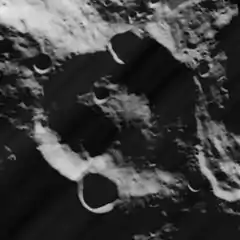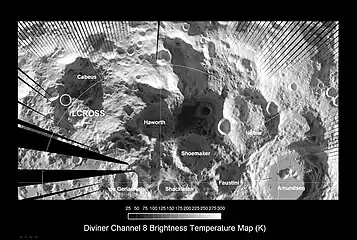Nobile (crater)
Nobile is a lunar impact crater that is located near the southern pole of the Moon. It was named after the Italian aviator and explorer Umberto Nobile by the International Astronomical Union (IAU) in 1994.[1] It lies to the south of the crater Scott, along the western rim of Amundsen. Between Nobile and the southern pole lie the smaller craters Shoemaker and Faustini.
 | |
| Coordinates | 85.28°S 53.27°E |
|---|---|
| Diameter | 79.27 km (49.26 mi) |
| Depth | Unknown |
| Colongitude | 323° at sunrise |
| Eponym | Umberto Nobile |
This is an eroded crater formation that is almost constantly cloaked in deep shadows. When sunlight does enter the interior of this crater, it does so at a very oblique angle. The crater rim is overlaid by several lesser craters, the most notable being a formation about half the diameter of Nobile along the western rim. There are also small craters along the southwest and northern parts of the rim. The outer rampart of Amundsen overlies the eastern rim and inner wall. The interior floor of this crater is somewhat irregular, and there are a few small craterlets across the surface.
Nobile was previously designated Scott A before being assigned a name by the IAU.
On 20 September 2021, NASA selected the western edge of Nobile as the landing site for the VIPER mission,[2] set to arrive in November 2024.[3]
In November 2021, the IAU named the small crater Stose (16.7 km diameter), located to the southwest of Nobile.[4] In August 2023, the IAU named two other small craters near Nobile. One is Burbridge (21 km diameter), located on the south rim of Nobile.[5] The other crater is Floss (9 km diameter), located near the northwest rim of Nobile.[6]
 Lunar Orbiter 4 image with north at top
Lunar Orbiter 4 image with north at top Lunar south pole as imaged by Diviner.
Lunar south pole as imaged by Diviner..png.webp) The west rim of Nobile is the proposed VIPER landing site.
The west rim of Nobile is the proposed VIPER landing site.
References
- "Nobile". Gazetteer of Planetary Nomenclature. IAU/NASA/USGS. Retrieved 6 September 2023.
- "NASA's Artemis Rover to Land Near Nobile Region of Moon's South Pole". NASA. 20 September 2021. Retrieved 20 September 2021.
 This article incorporates text from this source, which is in the public domain.
This article incorporates text from this source, which is in the public domain. - "NASA Replans CLPS Delivery of VIPER to 2024 to Reduce Risk". NASA. 18 July 2022. Retrieved 18 July 2022.
- "Stose". Gazetteer of Planetary Nomenclature. IAU/NASA/USGS. Retrieved 6 September 2023.
- "Burbridge". Gazetteer of Planetary Nomenclature. IAU/NASA/USGS. Retrieved 22 August 2023.
- "Floss". Gazetteer of Planetary Nomenclature. IAU/NASA/USGS. Retrieved 22 August 2023.
- Andersson, L. E.; Whitaker, Ewen A. (1982). NASA Catalogue of Lunar Nomenclature (RP-1097). NASA.
 This article incorporates text from this source, which is in the public domain.
This article incorporates text from this source, which is in the public domain. - Blue, Jennifer (25 July 2007). "Gazetteer of Planetary Nomenclature". United States Geological Survey (USGS). Retrieved 5 August 2007.
 This article incorporates text from this source, which is in the public domain.
This article incorporates text from this source, which is in the public domain.
- Bussey, B.; Spudis, P. (2004). The Clementine Atlas of the Moon. New York: Cambridge University Press. ISBN 978-0-521-81528-4.
- Cocks, Elijah E.; Cocks, Josiah C. (1995). Who's Who on the Moon: A Biographical Dictionary of Lunar Nomenclature. Tudor Publishers. ISBN 978-0-936389-27-1.
- McDowell, Jonathan (15 July 2007). "Lunar Nomenclature". Jonathan's Space Report. Retrieved 24 October 2007.
- Menzel, D. H.; Minnaert, M.; Levin, B.; Dollfus, A.; Bell, B. (1971). "Report on Lunar Nomenclature by the Working Group of Commission 17 of the IAU". Space Science Reviews. 12 (2): 136–186. Bibcode:1971SSRv...12..136M. doi:10.1007/BF00171763. S2CID 122125855.
- Moore, Patrick (2001). On the Moon. Sterling Publishing Co. ISBN 978-0-304-35469-6.
- Price, Fred W. (1988). The Moon Observer's Handbook. Cambridge University Press. ISBN 978-0-521-33500-3.
- Rükl, Antonín (1990). Atlas of the Moon. Kalmbach Books. ISBN 978-0-913135-17-4.
- Webb, Rev. T. W. (1962). Celestial Objects for Common Telescopes (6th revised ed.). Dover. ISBN 978-0-486-20917-3.
- Whitaker, Ewen A. (1999). Mapping and Naming the Moon. Cambridge University Press. ISBN 978-0-521-62248-6.
- Wlasuk, Peter T. (2000). Observing the Moon. Springer. ISBN 978-1-85233-193-1.